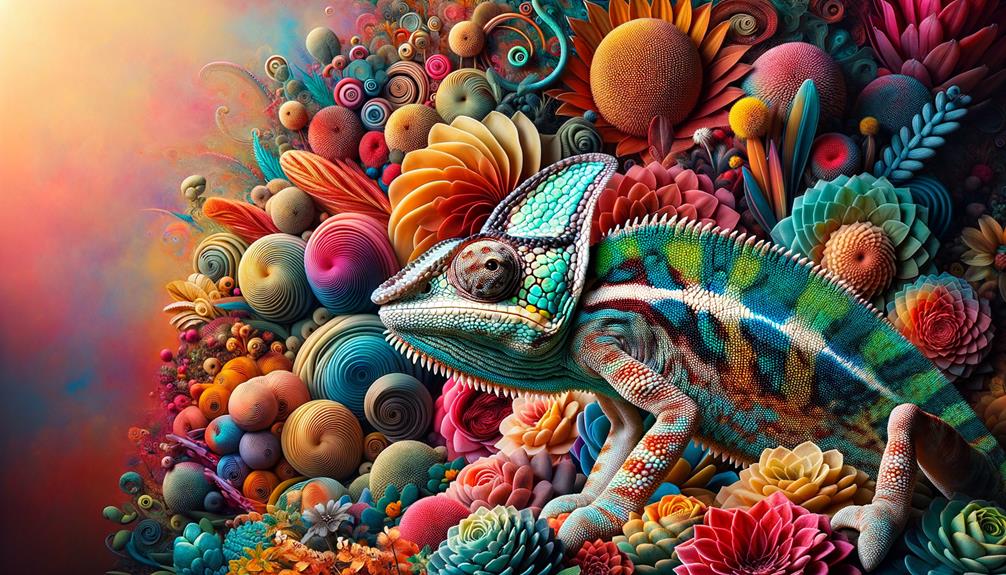Many people believe chameleons change color solely to blend in, but that's only part of the story. As a biologist, I can tell you they also do it to regulate their body temperature and communicate with others. When they darken their skin, they absorb more heat, and when they lighten it, they reflect sunlight and cool down. They also use vibrant colors to signal dominance or attract a mate, and more subdued tones to show submission. It's a complex and fascinating system that goes beyond simple camouflage. If you're interested in learning more about how these mechanisms work together, there's a lot to explore.
Key Takeaways
Chameleons can't blend in seamlessly with their surroundings; their color range is limited. In reality, color change in chameleons serves two main purposes: regulating their body temperature and conveying social signals.
When it gets cold, chameleons darken their skin to absorb heat, and when it gets hot, they lighten up to reflect it. This clever adaptation helps them maintain a stable body temperature.
Chameleons also use color to communicate with each other. Bright hues indicate dominance or readiness to mate, while more subdued colors signal submission or stress.
Their remarkable ability to change color rapidly is made possible by specialized skin cells called chromatophores and iridophores. These cells can expand or contract to change the color of the skin, allowing chameleons to adapt to their environment and express themselves in a split second.
The Purpose of Color Change
Many people have the wrong idea about why chameleons change color. It's not just about blending in with their surroundings. In reality, they do it to control their body temperature and communicate with each other. The key to this amazing ability lies in special cells called chromatophores and iridophores. Chromatophores contain pigments that can expand or contract, allowing the chameleon to change its color. Iridophores reflect light, making the colors even more vibrant.
Chameleons use color to express their emotions and social status. When a chameleon wants to show dominance or aggression, its cells make small adjustments that result in a bold, striking color. On the other hand, a chameleon that's feeling submissive or stressed might display more muted colors. These color signals play a crucial role in social interactions, especially during mating season when chameleons use bright colors to attract potential partners.
Regulating body temperature is another vital function of color change. By darkening their skin, chameleons can absorb more heat, while lightening their skin helps them reflect sunlight and cool down. Although they can change color to blend in with their environment, this ability is secondary to their primary needs of communication and temperature control. Understanding this dynamic reveals the true complexity behind a chameleon's color-changing abilities.
Myths About Camouflage

Chameleons' color-changing abilities are fascinating, but there's a common misconception that they can flawlessly blend into any background for camouflage. In reality, chameleons have a limited set of colors they can display. Their color changes serve multiple purposes, including social signaling and thermoregulation, not just camouflage.
Chameleons achieve their color change through specialized cells called chromatophores, which are tightly packed with pigments. These cells, combined with other layers of iridophores and melanophores, reflect light in various ways to produce the colors we see. However, this mechanism doesn't allow them to match every environment perfectly.
While natural selection has crafted chameleons to use color change in aiding concealment, it's not their primary defense. They rely more on their natural camouflage, body posture, and other evolutionary adaptations to avoid detection by predators. The myth of chameleons seamlessly blending into any background is just that—a myth not supported by science. Understanding these nuances allows us to appreciate their true capabilities and the evolutionary marvel that chameleons are.
Communication Signals

Chameleons' vibrant color changes serve as a sophisticated form of communication, signaling everything from dominance to mating readiness. These reptiles use their ability to change their color as a way to interact with others in their environment, not just to blend in. This natural signaling method is made possible by two layers of cells in their skin that allow them to adapt their appearance rapidly.
Imagine the following scenarios where chameleons use color changes to communicate:
- Dominance Displays: A male chameleon turns bright and bold to assert his dominance over another male, making it clear who's in charge.
- Aggression Signals: When intense color changes occur, it can indicate an impending fight, with the speed and brightness often predicting the outcome.
- Mating Readiness: Females display specific patterns and colors to signal their willingness to mate, letting potential suitors know they're interested.
In these social interactions, the color does not serve to camouflage but rather to convey important messages. Pet owners can even learn to interpret these signals, understanding the mood and intentions of their pets. It's often misunderstood, but the primary reason chameleons evolved this remarkable ability is not just to hide but to clearly communicate with their peers, making their world a colorful tapestry of non-verbal dialogue.
Temperature Regulation

Chameleons are masters of temperature regulation, and they achieve this through their incredible ability to change colors. Since they can't generate their own body heat, they've adapted to use color changes to control their body temperature. In cooler conditions, a chameleon will darken its skin to absorb more heat and light from the sun, allowing it to warm up efficiently.
On the other hand, when temperatures rise, chameleons will lighten their skin to reflect more light and heat, helping them stay cool. This remarkable ability ensures they can maintain an ideal body temperature regardless of their environment.
What's truly fascinating is that these color changes aren't about blending in with their surroundings, but rather about survival. By dynamically altering their skin color, chameleons can fine-tune their body temperature, allowing them to thrive in varied and often harsh climates. This thermoregulatory mechanism showcases the incredible adaptability of chameleons, highlighting that their color-changing ability is more than just camouflage – it's a crucial tool for their survival.
Dominance and Mating

Have you ever wondered how chameleons use their vibrant colors to establish dominance and attract mates? These masters of disguise change the color of their skin through specialized cells that contain nanocrystals, which reflect light in different ways, allowing them to switch between extreme color variations, like blue and green.
When it comes to dominance and mating, their color displays serve several purposes. For instance, dominant males flaunt bright colors to assert control over a territory and intimidate rivals – the more vivid the coloration, the stronger the signal of dominance. During mating season, males exhibit extreme color changes to catch the eye of potential mates, as bright colors signal their readiness to reproduce.
On the other hand, submissive chameleons adopt dull, muted hues to avoid confrontation, clearly signaling to dominant individuals that they pose no threat. Interestingly, females also use color to communicate their reproductive status. They might display bright colors when receptive or adopt darker shades to reject a male's advances.
The ability to reflect blue and green hues, combined with the color of their skin, creates a dynamic visual language that's critical for survival and reproduction. This complex communication system is essential for chameleons to thrive in their environment.
Frequently Asked Questions
What Is the Main Reason Chameleons Change Color?
For chameleons, color change is about more than just blending in. They use it to communicate with other chameleons, signaling things like dominance, aggression, or even readiness to mate. Plus, changing color helps them regulate their body temperature – getting darker to absorb heat or lighter to reflect it.
Can Chameleons Change Their Skin Color True or False?
Chameleons can indeed change their skin color, so it's true. They do this mainly for communication and temperature control, not just camouflage. However, they can't perfectly match any background, which is a common misconception.
What Is the Reason Why Chameleons Shift Colors Wherever They Go?
Chameleons aren't just color-shifting wizards for fun. They actually change colors to regulate their body temperature and communicate with others. Darker colors help them absorb heat, while lighter colors reflect it. They also use color changes to signal dominance, aggression, and even their readiness to mate. It's truly fascinating!
Are Chameleons the Only Reptiles That Change Color?
While chameleons are famous for their color-changing abilities, they're not the only reptiles that can shift their skin color. Other reptiles, like geckos, anoles, skinks, and agamas, can also change color using specialized cells called chromatophores. This ability helps them blend in with their surroundings, communicate with others, and even regulate their body temperature.



